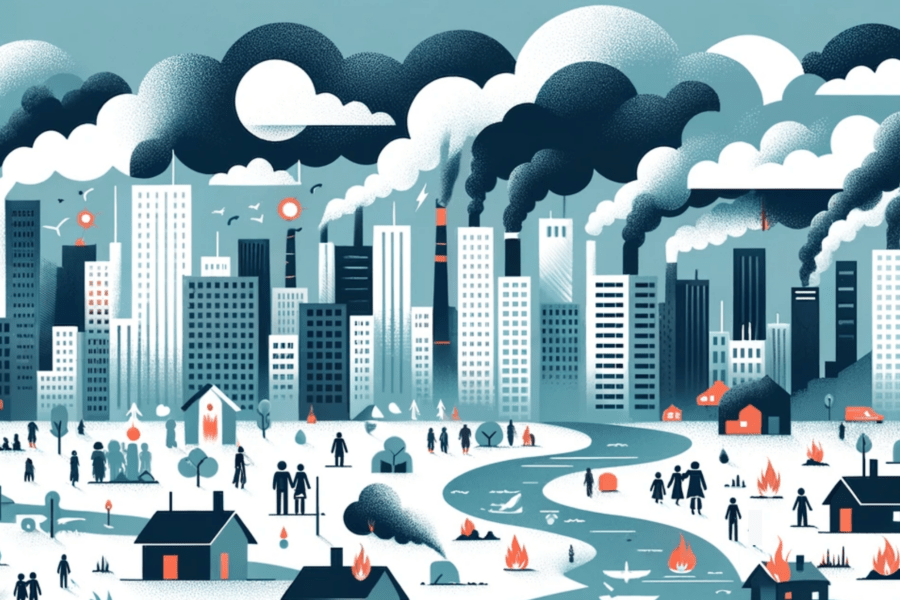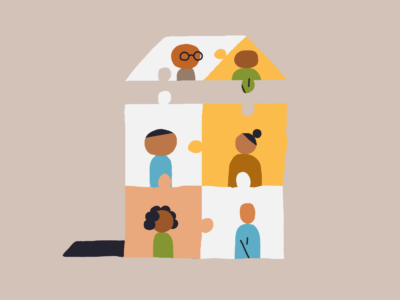Climate change poses a significant threat to vulnerable populations. When natural disasters strike, people with the fewest resources are most likely left without a place to live. The worsening climate crisis will disproportionately impact marginalized communities, communities of color, and people living in poverty — and will therefore result in increased homelessness.
We recently produced a detailed learning brief where we explore key concerns, including immediate health implications, social inequities, climate-driven displacement, and the impact on housing supply. Understanding these challenges forms a foundation for addressing this complex issue.
Four key takeaways
Immediate Health Implications
People experiencing homelessness face heightened health risks due to extreme heat and poor air quality linked to climate change — vulnerabilities that are amplified in urban areas with limited green space.
- Heat-related illnesses are increasing, exemplified in California, where homeless individuals comprised around 13% of heat-related hospitalizations from 2017 to 2021, despite representing less than half a percent of the state’s population.
- Poor air quality poses significant threats, with homeless individuals being disproportionately susceptible to chronic and life-threatening respiratory conditions.
Exacerbation of Social Inequities
Climate change will disproportionately affect vulnerable populations in the U.S. who are at greater risk of experiencing homelessness. Social inequities will worsen in the aftermath of catastrophic weather events. For many people on the margins, extreme weather events due to climate change can be a tipping point into homelessness.
- Lower-income households – who tend to live in older homes in high-risk areas – may be more likely to suffer damage to their homes during natural disasters.
- Those with limited financial resources often cannot afford homeowners or flood insurance and do not qualify for disaster loans.
- Low-value homes often cannot be replaced for the same price, leaving low-income households and renters with limited options.
- Eviction rates also surge in the aftermath of severe natural disasters.
Displacement and Housing Supply Shortages
Climate change contributes to the housing crisis by displacing people from their homes and reducing the supply of safe housing.
- More than 20 million people worldwide are displaced from their homes each year due to extreme weather events.
- Extreme weather events like wildfires and hurricanes leave people without safe homes to return to. Natural disasters damage residential properties, reducing housing supply, particularly in wildfire-prone regions. The cumulative effect increases housing instability and homelessness.
Migration Patterns Impacting Housing Availability and Infrastructure
Long-term climate change consequences, such as droughts and rising sea levels, will influence where people can live.
- Some may migrate from high-risk areas, impacting housing supply, transportation, and labor markets.
- Vulnerable populations, including those experiencing homelessness, may have fewer choices and stay in high-risk areas, which could strain resources and infrastructure in safe havens.
Recognizing the unique vulnerabilities faced by people at risk of homelessness, the lack of affordable and sustainable housing in many areas, and the climate crisis is vital for developing effective policies and interventions.
The consequences of climate change have already begun to disproportionately affect the most vulnerable groups globally, including those without stable housing. It is essential to act now to mitigate social disparities, protect individuals and communities from displacement, and invest in the resilience and sustainability of our communities.
What can we do?
- Develop effective policies and interventions recognizing a triple threat crisis — climate, housing shortages, and homelessness.
- Build upon the initial, promising efforts to end homelessness — like Built for Zero. Not having people subsist in street environments obviates the need for emergency responses to their exposure to weather extremes.
- Ensure our public leaders invest in an abundance of all types of housing. Access to affordable and supportive housing models are proven means of helping people.
- Build climate resilience and response plans that incorporate homeless populations in collaboration with people with lived experience.




